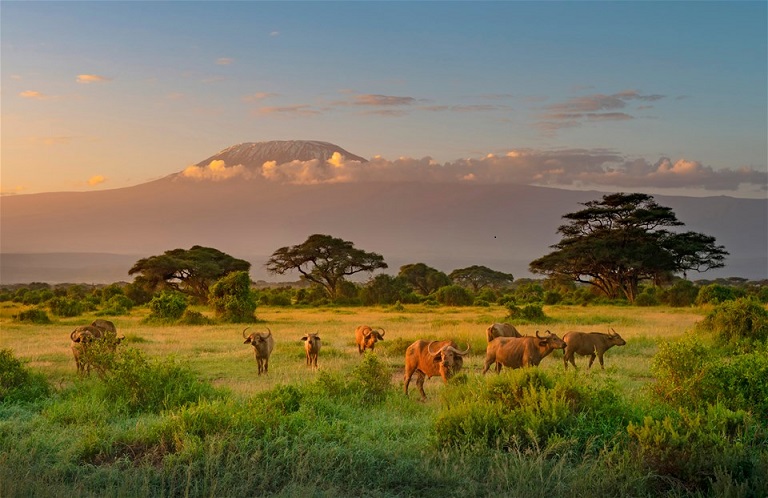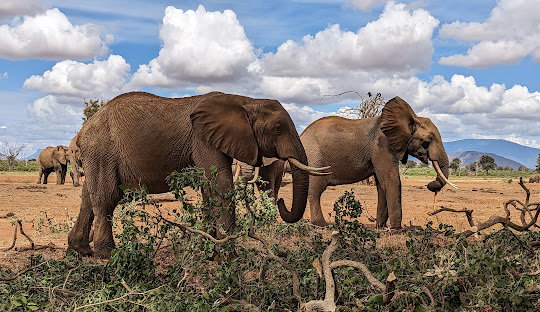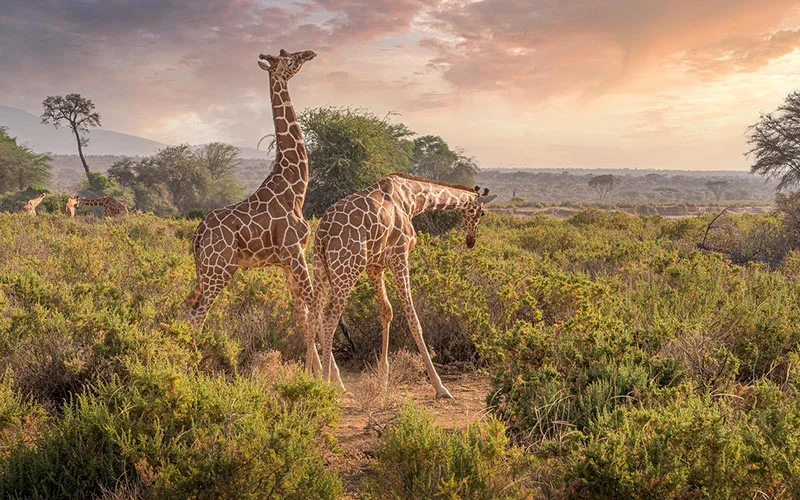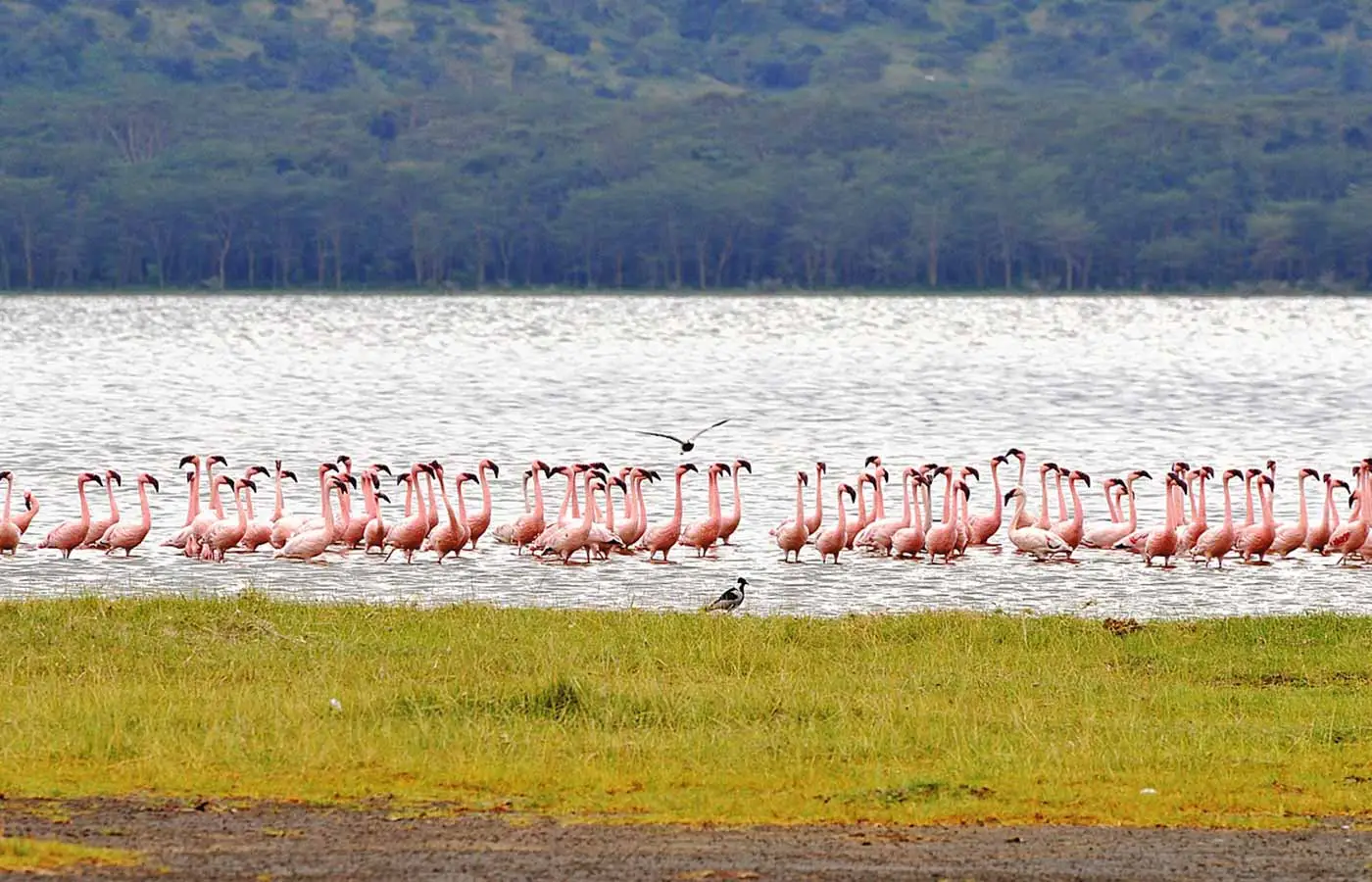Kenya needs no introduction for its diverse ecosystems, rich history, and timeless culture. With its savannas inhabited by the Big Five, mighty mountains, and breathtaking natural beauty, it’s one of Africa’s ultimate playgrounds for adventure and safari lovers. Whether witnessing the iconic Great Migration in the Maasai Mara, exploring wildlife at Nairobi National Park, or simply relaxing on the pristine Diani Beach, the first thing to know when planning a holiday here is the best time to visit Kenya. And this guide covers it all!
Kenya’s Climate Overview
 Kenya is situated on Africa’s east coast, bordering the Indian Ocean and countries like Somalia, Tanzania, and Uganda. Its climate is largely influenced by its proximity to the equator and diverse topography, characterized by two rainy seasons and two dry seasons. They mainly include:
Kenya is situated on Africa’s east coast, bordering the Indian Ocean and countries like Somalia, Tanzania, and Uganda. Its climate is largely influenced by its proximity to the equator and diverse topography, characterized by two rainy seasons and two dry seasons. They mainly include:
1. Coastal Climate: Kenya’s coastal strip along the Indian Ocean, with destinations such as Mombasa and Diani, is hot and humid year-round. The average temperatures range from 22 degrees Celsius to 32 degrees Celsius. The heat peaks from January to March, while April to June and October to December bring heavy rainfall. The region experiences cooler, dry weather from July to October.
2. Highland Climate: The country’s central highlands, including Nairobi and Mount Kenya, feature a tropical climate, thanks to their high-altitude location. For instance, Nairobi, at over 1,790 meters, has average temperatures ranging from 12 degrees Celsius to 24 degrees Celsius. The region also experiences two rainy seasons: a long rainy season from March to May and a short season from October to December. Overall, this climate is considered one of the world’s best.
3. Savanna (Semi-Arid) Climate: Hot days, cool nights, and relatively less rainfall define this climate, mainly in regions like Maasai Mara, Amboseli National Park, and Samburu National Park. They mostly receive short rains from October to December, when the whole area is lush, refreshing, and even crowd-free. The dry season generally lasts from July to October and is widely regarded as the best Kenya safari season.
4. Desert (Arid) Climate: Much of Kenya (more than 80%), from its northern part, encompassing Turkana County, to the Eastern Province, experiences an arid climate. Daytime average temperatures often rises above 35 degrees Celsius. Moreover, the region experiences low or highly occasional rainfall, mostly resulting in drought. All these indicate is that tourism is limited in this region due to its mostly harsh and challenging conditions.
 Featured
Featured  Featured
Featured Kenya Weather by Month: A Quick Guide
Knowing the Kenya weather by month allows you to make the most of your holiday. So, be sure to refer to the following breakdown to plan your getaway.
January: This month is a part of the country’s peak season, with pleasant weather and less rainfall. As it’s a dry period, it’s the best month to visit Kenya for game viewing, bird watching, and even beach holidays. It’s also a great time to spot elusive creatures, including leopards, in their natural habitat.
- Coast: Dry season with temperatures from 24 degrees Celsius to 32 degrees Celsius
- Highlands: Mild sunny with temperatures from 14 degrees Celsius to 26 degrees Celsius
- Safari regions: Warm days, cool nights, little rainfall
February: Similar to January, Kenya in February is generally dry, offering exceptional wildlife viewing and bird watching opportunities. Coastal areas are also at their best, perfect for diving, snorkeling, and whale and shark sightings, among other water experiences.
- Coast: Dry season with temperatures from 28 degrees Celsius to 32 degrees Celsius
- Highlands: Dry and pleasant
- Safari regions: Dry season
March: It’s when rainy season begins in Kenya’s coastal and highland areas, making the landscape lush and refreshing. It’s ideal for capturing stunning wildlife photographs. It’s also considered prime lion season, allowing you to observe lions and their prides. Migratory birds are also abundant during this month.
- Coast: Rainfall with temperatures from 24 degrees Celsius to 33 degrees Celsius
- Highlands: Start of long rains with temperatures from 15 degrees Celsius to 25 degrees Celsius
- Safari regions: Occasional showers with temperatures from 15 degrees Celsius to 28 degrees Celsius
April: This month sees the peak of the long rainy season, mostly characterized by moderate temperatures, high humidity, and muddy landscapes in the safari regions. Tourism slows, but the blend of heavy rains, lush greenery, and fewer crowds offers a relaxed way to take in the region’s wildlife and safaris.
- Coast: Heavy rains with temperatures from 22 degrees Celsius to 30 degrees Celsius
- Highlands: Peak of long rains with temperatures from 10 degrees Celsius to 24 degrees Celsius
- Safari regions: Wet, muddy season with temperatures from 26 degrees Celsius to 32 degrees Celsius
May: Rainy season continues in most parts of the country this month, turning the landscape lush, green, and incredibly scenic. As it’s a low season, it’s perfect for travelers looking for a budget-friendly Kenyan escape.
- Coast: Warm, humid, and rainy with temperatures peaking to 30 degrees Celsius
- Highlands: Rain continues with cooler nights
- Safari regions: Warm weather with lush landscapes
June: Kenya in June marks the beginning of the dry season, with ample sunshine and moderate humidity, making it the ideal time for safaris and hiking in the highlands. The best part is that the region is still crowd-free, ensuring a relaxed wildlife viewing experience.
- Coast: Less rain with temperatures from 28 degrees Celsius to 32 degrees Celsius
- Highlands: Dry and cool with temperatures from 20 degrees Celsius to 26 degrees Celsius
- Safari regions: Dry season begins with temperatures from 15 degrees Celsius to 25 degrees Celsius
July: This month falls in the dry season, so you can expect mild temperatures with clear skies and relatively cooler evenings. It officially marks the tourist season, attracting large crowds looking to witness the Great Migration and enjoy safaris across the savannas.
- Coast: Warm and less humid with temperatures from 28 degrees Celsius to 32 degrees Celsius
- Highlands: Cool and dry with temperatures from 20 degrees Celsius to 26 degrees Celsius
- Safari regions: Peak dry season with temperatures from 23 degrees Celsius to 27 degrees Celsius
August: Temperatures drop, the weather becomes pleasant, and crowds grow this month. Not to mention, it’s one of Kenya’s busy months for its perfect beach weather and fantastic wildlife viewing opportunities, including game drives, walking safaris, and witnessing the Great Migration.
- Coast: Warm and dry with temperatures from 25 degrees Celsius to 30 degrees Celsius
- Highlands: Pleasant and dry with temperatures from 20 degrees Celsius to 26 degrees Celsius
- Safari regions: Exceptional wildlife viewing experiences across dry savannas
September: This month is also part of the peak tourist season due to pleasant weather and ideal wildlife viewing adventures, especially for taking in the Great Migration in the Maasai Mara.
- Coast: Warm and low rainfall with temperatures from 21 degrees Celsius to 29 degrees Celsius
- Highlands: Dry with temperatures from 20 degrees Celsius to 26 degrees Celsius
- Safari regions: Perfect for the Kenya safari season with temperatures from 18 degrees Celsius to 22 degrees Celsius
October: This month is mostly dry with brief, occasional rains, making it perfect for both safaris and beach holidays. It’s also when national holidays like Mashujaa Day take place.
- Coast: Start of short rains with temperatures from 28 degrees Celsius to 32 degrees Celsius
- Highlands: Short rains begin with cooler temperatures from 20 degrees Celsius to 26 degrees Celsius
- Safari regions: Short rains with temperatures from 30 degrees Celsius to 35 degrees Celsius
November: Crowds begin to decline, allowing for a laidback wildlife adventure in renowned safari regions like Maasai Mara. You can spot various birds and animals such as lions, elephants, and giraffes without the usual swarming.
- Coast: Fewer crowds with temperatures from 23 degrees Celsius to 32 degrees Celsius
- Highlands: Cooler temperatures with temperatures from 20 degrees Celsius to 26 degrees Celsius
- Safari regions: Lush and green with temperatures from 20 degrees Celsius to 30 degrees Celsius
December: Plenty of sunshine, moderate humidity levels, and short rains make this month ideal for perfect beach activities and excellent wildlife viewing.
- Coast: Warm with temperatures from 23 degrees Celsius to 32 degrees Celsius
- Highlands: Mild and partly rainy with temperatures from 20 degrees Celsius to 26 degrees Celsius
- Safari regions: Safari season with short rains
This offers lush surroundings and vibrant wildlife encounters. It’s also a great month to explore the hidden gems of Nairobi, as the city feels lively and festive with a mix of culture, nature, and local experiences.
Best Time to Visit Kenya
 For Wildlife Viewing: Kenya is most visited for its wildlife safaris. So if your holiday is focused on gaming and safari adventures, the ideal time to visit is during the long dry season from June to October. January and February are also the best times for safari in Kenya. With warm weather, clear skies, and minimal rainfall, these months offer the most rewarding and memorable wildlife sightings.
For Wildlife Viewing: Kenya is most visited for its wildlife safaris. So if your holiday is focused on gaming and safari adventures, the ideal time to visit is during the long dry season from June to October. January and February are also the best times for safari in Kenya. With warm weather, clear skies, and minimal rainfall, these months offer the most rewarding and memorable wildlife sightings.
For the Great Migration: The Great Migration is considered the largest land mammal migration. It’s when over a million wildebeest, gazelles, and zebras, among others, migrate from Tanzania’s Serengeti to Kenya’s Maasai Mara, in search of nutritious grass and water. The most ideal time to witness this extraordinary phenomenon is in August and September, when dramatic river crossings and unforgettable wildlife sightings are almost guaranteed.
For Hiking Mount Kenya: Hiking Mount Kenya tops the wish list for many outdoor enthusiasts. With stable weather, clearer trails, less rainfall, better visibility of the mountains, and bright skies, the dry seasons from January to March and July to October is the best time to go on an exciting hiking trip in Kenya.
For Beach Holidays: The dry season is most recommended for a beach holiday in Kenya. If your itinerary is packed with water sports like kite surfing, consider visiting here between June and September. If you don’t want to skip Kenya’s beaches for their exuberant nightlife and festivals, the ideal time to visit here is from December to January. This period also offers perfect weather conditions for water activities such as swimming, sunbathing, snorkeling, and diving.
For Birdwatching: Birdwatchers are in for a treat in Kenya, especially when they visit here during the wet season from November to April. It’s when migratory birds from Asia and Europe flock here for breeding in its lush, green landscape.
For Budget-Friendly Travel: The low season from November to December usually sees fewer crowds with surprisingly exciting wildlife viewing opportunities. The best thing is that accommodations, lodges, and safaris are priced lower, allowing for a wallet-friendly getaway. The shoulder season, from September to early November, also allows for a cost-effective holiday, with the bonus of pleasant weather and the approach of peak season.
Practical Travel Tips
- Book your accommodation, activities, flights, and other staples in advance to avoid last-minute hassle; consider an all-inclusive holiday, such as a Nairobi tour package.
- Consult a healthcare provider before your trip to discuss malaria precautions and any necessary vaccinations.
- Stay hydrated and drink only bottled or boiled water.
- Be sure to apply plenty of sunscreen due to ample and intense sunlight.
- Dress modestly when visiting rural areas and religious attractions.
- Carry comfortable, lightweight clothing and a good pair of shoes for your Kenyan getaway.
Conclusion
Kenya’s breathtaking landscapes, remarkable wildlife, and rich cultural heritage promise an unforgettable holiday. Now that you know when to visit Kenya, all that’s left is to bookmark this guide and start planning your long-awaited African getaway.
FAQs

